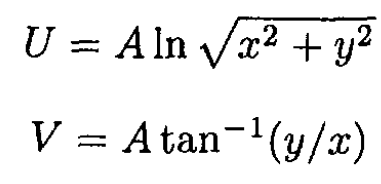
Principle of Conformal Mapping
 المؤلف:
Sidney B. Cahn Boris E. Nadgorny
المؤلف:
Sidney B. Cahn Boris E. Nadgorny
 المصدر:
A GUIDE TO PHYSICS PROBLEMS
المصدر:
A GUIDE TO PHYSICS PROBLEMS
 الجزء والصفحة:
part 1 , p 56
الجزء والصفحة:
part 1 , p 56
 11-8-2016
11-8-2016
 1349
1349
Principle of Conformal Mapping
a) Show that the real part U(x, y) and the imaginary part V(x, y) of a differentiable function W(z) of z = z + iy obey Laplace’s equation.
b) If U(x, y) and V(x, y) above are the potentials of two fields F and G in two dimensions, show that at each point (x, y), the fields F and G are orthogonal.
c) Consider the function W(z) = A ln z, where A is a real constant. Find the fields F and G and mention physical (Electrodynamics) problems in which they might occur.
SOLUTION
A differentiable function W(z) = U(x, y) + iV (x, y) satisfies the Cauchy Riemann conditions
 (1)
(1)
To check that U and V satisfy Laplace’s equation, differentiate (1)

or

Similarly,

and

b) Orthogonality of the functions F and G also follows from (1):

c) The electric field of an infinitely long charged wire passing through the origin is given by  where A = -2λ and λ is the charge per unit length, r is the distance from the wire (see Figure 1.1). The complex potential
where A = -2λ and λ is the charge per unit length, r is the distance from the wire (see Figure 1.1). The complex potential


Figure 1.1
So

The fields F and G are given by

Note how F and G satisfy the conditions of parts (a) and (b). The magnetic field of a similarly infinite line current can be described by the same potential.
 الاكثر قراءة في مواضيع اخرى
الاكثر قراءة في مواضيع اخرى
 اخر الاخبار
اخر الاخبار
اخبار العتبة العباسية المقدسة


